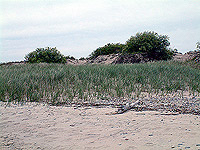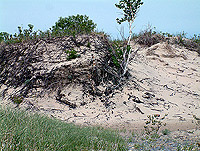Big Sandy Bay's Ecosystem
 Getting to the beach at Big Sandy Bay by land means a walk through its sand dunes, which begs the question — just what are sand dunes? Dune systems like the one at Big Sandy Bay have four distinct parts: beach, fore-dune, back dune, and wetlands. The beach at Big Sandy has two noticeable sections — a wet section and a dry section.
Getting to the beach at Big Sandy Bay by land means a walk through its sand dunes, which begs the question — just what are sand dunes? Dune systems like the one at Big Sandy Bay have four distinct parts: beach, fore-dune, back dune, and wetlands. The beach at Big Sandy has two noticeable sections — a wet section and a dry section.
Big Sandy's wet section is defined by the waves pushed in across the beach by the prevailing southwesterly winds of the region. The patterns of differently coloured layers of sand is one of the noticeable features of this portion of the beach. The second part of the beach, the dry section, is normally out of the reach of the constant flow of water in the bay. It's this dry section that begins the dune-building process by providing a supply of light weight, dry sand for the wind to blow inland from the beach, and which plays a role in the constantly shifting formation of dunes.
 The transition between beach and fore-dune is marked by the growth and accumulation of low-lying vegetation and grasses. At Big Sandy Bay we see Champlain Beachgrass (Ammophila champlainensis), Beach Pea (Lathyrus japonicus), and Artemisia growing from slightly above the storm line to the inland edge of the dune system. This dune sequence is interupted in places where the dune has been "blown-out", often as a result of a weakening of the vegetation's root systems through human intervention or severe weather conditions. In past years, unrestricted ATV traffic contributed to many blow-out areas at this site. Restoration of the dunes from this mainly human damage will take many years.
The transition between beach and fore-dune is marked by the growth and accumulation of low-lying vegetation and grasses. At Big Sandy Bay we see Champlain Beachgrass (Ammophila champlainensis), Beach Pea (Lathyrus japonicus), and Artemisia growing from slightly above the storm line to the inland edge of the dune system. This dune sequence is interupted in places where the dune has been "blown-out", often as a result of a weakening of the vegetation's root systems through human intervention or severe weather conditions. In past years, unrestricted ATV traffic contributed to many blow-out areas at this site. Restoration of the dunes from this mainly human damage will take many years.
After the fore-dunes we find the back dunes, which are made up of larger dunes with not only a higher density of vegetation, but also with a greater variety of plant life and including several species of trees. As with many coastal-dune systems, an inland line of back dunes called the ridge can easily be picked out at Big Sandy Bay. This ridge marks a boundary between the primarily sandy coastal-dune ecosystem and the wetlands behind it.

